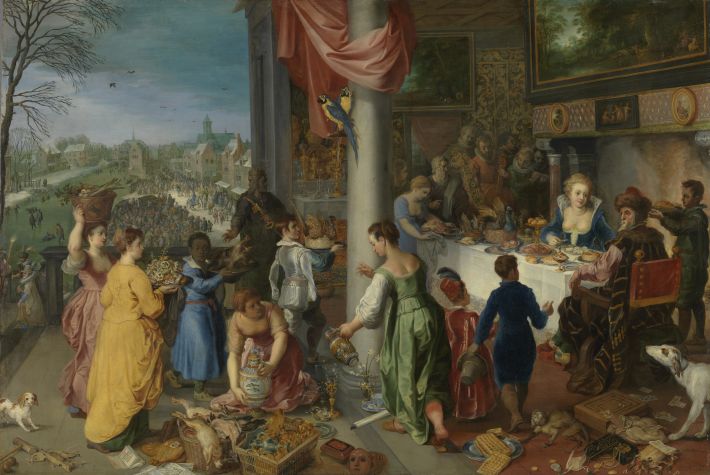Silverware: Objects for Show and Everyday Use at the Ximenez House
The Ximenez-da Vega inventory counts as a special case among the inventories to have survived from seventeenth-century Antwerp and much the same can be said of the silverware itself and where it was kept. Smaller collections of silver were generally stored in chests made of iron or iron-bound wood, or in the comptoir or office. At the Ximenez house, however, both silverware and jewelry were kept in a special strong room "above the hall of the back house." Some households, especially princely households, used attic repositories for the safekeeping of valuables. The silver stowed away in such "Gewelffcamerken" was thought to be safely beyond the reach of unauthorized persons and was protected against tarnishing when not in use. The Ximenz-da Vega inventory is unusual in that it also indicates where the silver was displayed, namely in the "large sitting room or downstairs room in the back house," which contained a "dresser of walnut wood with a set of steps of the same material." This same dresser was probably decked out with a Turkish carpet, which would have had the effect of making the silver displayed on top of it look even more precious.
The objects in the house were many and varied. Drinking vessels occupy an important place in the Ximenez-da Vega inventory, though the predominant silver objects in the household were plates, bowls, and similar objects. Metal holders for drinking glasses were also prominent; furthermore, there were a considerable variety of table utensils, such as pepper boxes and salt cellars. Especially remarkable are the two "saucieren," which must have been quite large-bellied bowls (gravy boats for the sauces used to add flavor to various dishes have existed since the Late Middle Ages, but the boat shape that eventually gave them their name did not develop until around 1700). Also notable is the large number of spoons and forks. Three "rechauffoirs," or chafing dishes for keeping food warm, clearly also belonged to the tableware. They were not uncommon in seventeenth-century Antwerp, although they may have counted as a fashionable novelty at the time. The lavabo sets used for washing hands at table would have played a largely ceremonial role; their size and weight also made them appreciated as gifts. Of the three listed in the Ximenez inventory, one was of German manufacture.
One rather long entry merits closer attention since it may refer to one of the first travel dinner services, a type which in those days was still in its infancy: the entry describes a casket containing twelve spoons and forks and possibly also had room for drinking vessels, a salt cellar, carafe, and other such items. The last piece from the group of 'secular' silverware to warrant mention is a flower basket with openwork sides, most surviving examples of which from the northern Netherlands date from c. 1650-1670. Two items of 'sacred' silverware, a stoup and an incense burner, can be read as evidence of the Counter-Reformation's impact on Antwerp life.
The lavish stock of Ximenez-da Vega silverware appears to have consisted almost exclusively of objects made in Antwerp or at least in Flanders, with a few pieces of German provenance as the only exception. Astonishingly, the list of silverware does not feature any drinking vessels incorporating exotic materials, such as are found elsewhere in the inventory and appear to reflect Emmanuel Ximenez's personal interests. The silverware with a cumulative weight of about 103 kilograms consisted primarily of luxury items intended for display on the buffet and table. What shines through the entries is the early modern trend towards keeping a wide range of utensils, including sauce dishes and condiment sets, so as to make dining as convenient and pleasurable as possible; yet no less remarkable is the apparent homogeneity of the various sets of plates and cutlery. The holdings of the Ximenez-da Vega household far exceeded known comparable holdings of silverware in Antwerp in the first half of the seventeenth century.
Literature
Baatsen, Inneke, and Bruno Blondé. "Zilver in Antwerpen. Drie eeuwen particulier zilverbezit in context." Zilver in Antwerpen. De handel, het ambacht en de klant. Ed. Leo De Ren. Leuven: Peters, 2011. 95-125.
Claessens-Peré, Anne-Marie, ed. Zilver voor Sir Anthony. Exh. cat., Provinciaal Museum Sterckshof/Zilvercentrum, Antwerp. Gent: Snoeck, Ducaju & Zoon, 1999.
Van Hemeldonck, Godelieve. Het Grootwerk. Goudsmeden, zilversmeden en juweliers vermeld te Antwerpen, 13de-19de eeuw. CD-ROM. Antwerp, 2005.

Jan Brueghel the Elder and Hendrik van Balen, Winter, 1616, Alte Pinakothek, Munich. Image: Bayerische Staatsgemäldesammlungen - Staatsgalerie Neuburg.


